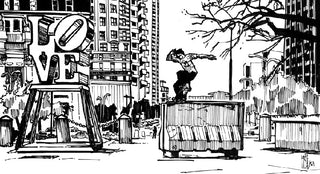I met Quincy Renon, aka Kwills, through sneaker message boards in the mid 2000s.
He lived in the deep south of the Netherlands and worked at an outlet center, which made him a valuable source to keep up with the latest drops at the outlet stores of brands like Nike, adidas, and Vans. I always knew he had a graffiti background, but it wasn’t until he started to work as Kwills that I really got to see what he had in store. Since then, he’s worked for brands like PUMA, ASICS, and Jagermeister; sneaker conventions like Solemart and Sneakerness; magazines like Sneaker Freaker and Sneakers Mag; and shops like AFEW, Calico Jack, 24/7, and Foot Patrol.
On top of that, he’s put out his own products, including the much-desired “Miffy Supreme” graphic, which shows the world’s most famous bunny in a Supreme box logo tee. On a recent trip to London, we barely managed to make it down a street in Soho without someone shouting his name or coming over to shake his hand. While we’ve shared many good conversations over the years, I decided to stop by his house after an outlet trip to delve deeper into the art of the one they call Kwills.
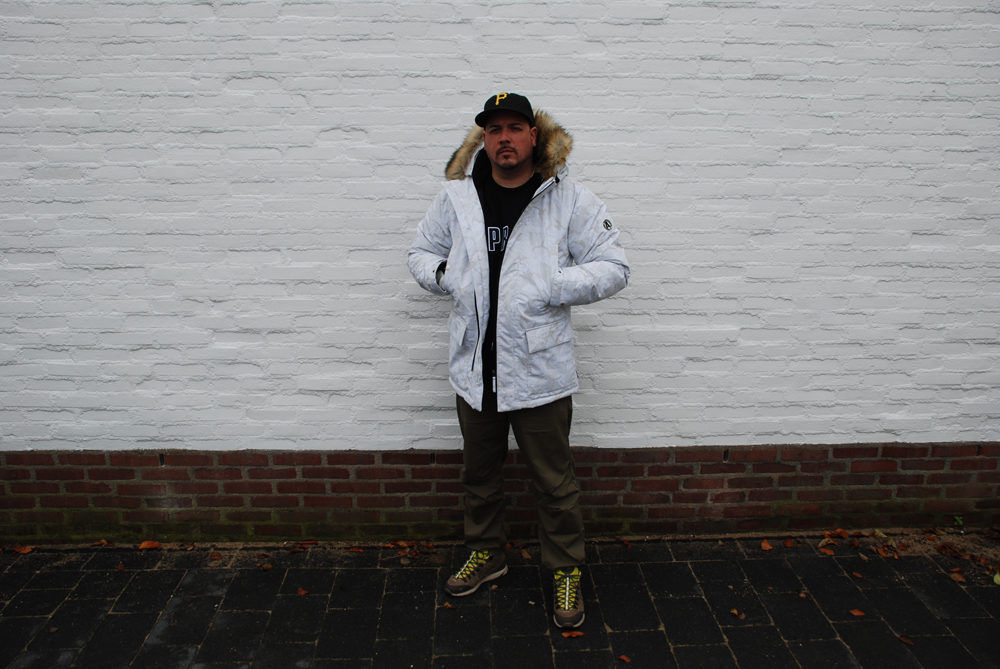
Introduce yourself.
I’m Quincy Renon, 40 years old, and I’ve been working as a draughtsman under the moniker of Kwills since 2011.
A lot of your work is inspired by things you were around back when you were younger. Skateboarding, graffiti, hip-hop, movies, sneakers—can you tell us a bit about your childhood?
My childhood years really formed me into the person I am today. I got into skateboarding in elementary school. Back then you had those slim boards with the fat wheels. I saw it in the media and I was triggered right away to try it. Then you graduate onto the wide toy store decks, which were completely horrible. From there, you end up at your local skate shop—mine were Somers and Van Nierop in Roermond. In that last shop, I bought my first pro set-up: A Triple X (Brand X) Ken Sigafoos deck, Gullwing trucks, and (Kryptonics) Slammers wheels. Basically, all we did at the time was just… roll. We didn’t know that you could do other things on a board. Eventually, you start getting your hands on magazines like Thrasher and Transworld. Back then, they had trick tips in the mags, so you could learn how to do tricks like a board slide or a boneless. Through that and videos that guys had imported from the States, a whole new world opened itself up for me and I was instantly hooked. There’s an ultimate freedom in skateboarding, you decide what you want to do. I had been really into drawing things ever since I was five years old, so the board graphics really spoke to me. Brands like Powell-Peralta, H-Street, Vision Street Wear, [and] Santa Cruz introduced me to things I’d never seen before. Their graphics became a huge influence on my drawing. Drawing is just like skateboarding, you decide what you want to draw. Back then, heavy metal and punk were the soundtrack to skateboarding, but videos like the Zoo York Mixtape introduced me to hip-hop, which had a lot of impact on me as well.
As a young skater, did you ever think your art would eventually make it onto decks?
As a kid, I had two big dreams: Opening a skateshop or launch my own clothing line. I’ve worked in retail for years and always continued to draw and that led me to printing my own shirts. And now, I have a collaboration with [British skateboard brand] Skateboard Cafe, but honestly, I never saw it coming. Doing graphics for them inspired me to go out and find a manufacturer that could help me print my own decks. I went for it and my first deck, which featured my Supreme Miffy graphic, sold out in 20 minutes. That showed me people were interested, so [I continued] to do boards. Not trying to launch a full on brand, but do fun, limited, projects every now and then. I just put out a Wu-Tang Clan deck with my interpretation of the the Enter The Wu-Tang artwork, in a limited run of 36 decks.

Let’s talk about the drawing. You said you started when you were five—what made you continue to do it? Most kids draw at that age, but many of them lose interest in it eventually.
I’ve done some research on this, and most kids stop drawing around the time they turn 11, 12 years old. Kids start drawing their version of reality. That’s why at first the people they draw only have a head and feet, no body. They don’t know anything about anatomy, they just identify people by their face and they see the legs since they’re so small. Throughout the years, their senses develop, and that shows in their drawings. But eventually they’ll hit a bump in that development, and that’s usually around the time they go to high school. At that time, parents get involved: “Well, all that drawing is cool and all that, but you need to think of your future.” Not sure if it’s still the case, but back then, schools and parents thought of artists as poor lowlives who had very little potential to be successful. I’ve had some serious conversations with my parents when I was about to graduate high school and wanted to go to art school. My mom was afraid that if I became a full-time artist, I’d become a guy who had to go door to door, selling his paintings to be able to afford rent and food. But I already had a plan, inspired by skateboarding. My focus was on applied arts. I wanted a brand to pay me to design a T-shirt or a skateboard. The freedom of drawing—which I spoke about earlier—was something I could not let go.
How did you develop your current style?
In 2012, I had a meeting with an Amsterdam-based art agency. I came to their office, hoping to be part of their portfolio, and showed them my work. They rejected me. My style was so clean that it had lost its edge. During the interview, they asked if I had any other work on me besides the portfolio I brought. I had some sketchbooks on me, which I reluctantly showed him since they were very personal. When he reached the third page of the first book he asked me why I hadn’t shown these first. He recognized that those drawings were so much closer to me, to who I am as an artist. If I’m completely honest, I knew my work lacked something, a soul of some sort, but I couldn’t pinpoint it myself. After that talk, I decided to start focusing more on that more personal style. In 2014, I started a 365 day drawing challenge. That was a great way to force myself to develop my style more and push myself as an artist.
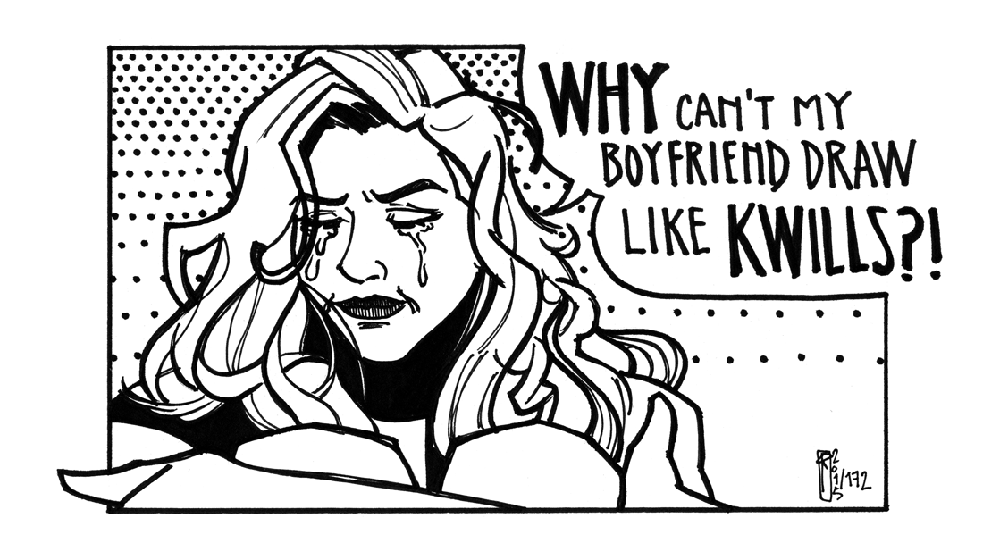
In 2011, you “rebranded” yourself as Kwills. Tell us about the how and why.
I graduated art school in 2002. Most people who graduate art school are kinda lost when they finally get that diploma. Very few of them start making [enough] money with their art right away, so survival mode kicks in. Your focus switches on making money and getting by first, and art second. After I graduated, I started working in the local outlet center at shops like Zoo York, Vans, and, nowadays, Nike. During that time I created art under the name Kwinz. That was the name I used when I was heavily into graffiti. But after a while, I wanted something new—a new chapter in my life so to speak. The name Kwills is a combination of “Quincy” and “illustrations.” I wanted to do Quills, but sadly, that name was already taken, so I took the phonetic approach from my old graff name and merged it with what I was now focusing on: Illustrating.
Around that time, I got a call from Martin (Van Dijk), a good friend of mine. He was in touch with Solebox founder, Hikmet Sugoer, about bringing the sneaker selling event, Solemart, to the Netherlands. The event was going to take place in Martin’s hometown, Eindhoven. He asked me to be part of it and design all the graphics, banners, flyers, T-shirts, etc. Of course I said yes because I’ve always been heavily involved in the sneaker community. At that point, Kwills really took off. The event was visited by a lot of people who were kind of a big deal in the sneaker community, and, all of the sudden, they see your artwork on these huge banners outside of the building. I saw the potential and put some extra effort in the merchandising. We did some great T-shirts and through a hook up, I got a bunch of blank New Era caps and found a factory who could stitch them the right way. At the event, I drew small canvases of sneakers people brought to my table, and there was a raffle for a large canvas I did for the event. After that, it really took off, especially my drawings of sneakers, [they] started to get a lot of fans. Through that, I met a lot of people, some of which happened to be in important positions at brands who eventually hired me to do projects.
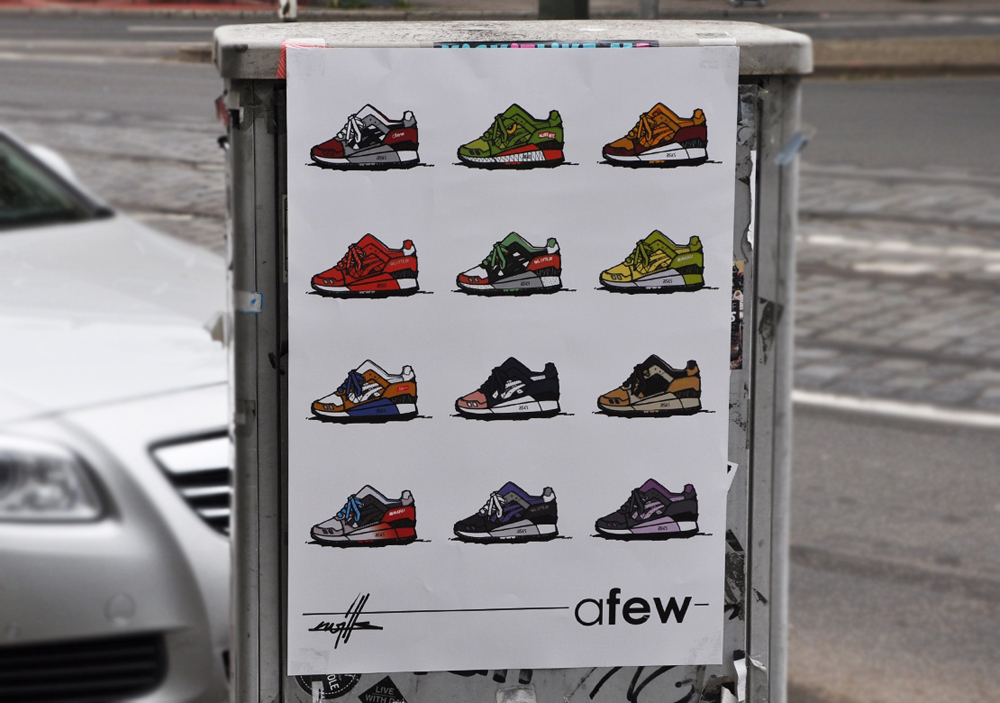
How did you convert your newfound popularity into paid assignments?
Most of the time it happens on a personal level. I never bother to ask people who I meet about what they do or try to find out how important they are. I just try to find a common ground to connect with them. A guest speaker at my art school once told me: “If you can sell your work without showing your work, you got a good thing going.” Some artists are too thirsty. They tell every person they meet that they’re a designer and that they’ve [worked] on this or worked with this and this brand or whatever. More than often it ruins the moment of just getting to know people and sharing a beer. I just strike up conversations with people, and at the end of the night, they ask me what I do, and more than often it rings a bell. Because we made a connection before the subject of me being an artist comes up, the respect is already there and they’ll think of me when they’re looking for an artist for a project. I like making new friendships with kindred spirits. If that evolves into a project, that’s great. If I get paid for it, even better. But the friendship and the personal connection is what matters most to me.
Your work gets a lot of recognition outside of the Netherlands. I’d even say you’re more popular in countries like Germany and England than you are in your own country. Do you have any idea why that’s the case?
That Solemart event in Eindhoven had a lot to do with it. Solemart is a concept by Solebox, the sneaker shop from Berlin, so there were a lot of German visitors at that event who were all introduced to my work. Around that time, Sneakerness started to expand into Germany as well. I visited their first convention as a seller, selling some of my own shoes at the event. At that event, certain people recognized me from Solemart and introduced people to me. One of them was the head of Sneaker Freaker Germany. They were a part of every Sneakerness event, and they gave me a chance to showcase my sneaker drawings in their booth for a period of two years. That gave me a lot of exposure within the sneaker community. Through that, I had interviews in the German Sneaker Freaker and Sneakers Mag, and on the French Sneakers Addict website, and my name and reputation started to grow. I did a few T-shirts with Sneaker Freaker Germany, which sold out instantly. I am still amazed by how many people in Germany know about me or my art. It’s a really big country, but everywhere I go, there’s always someone who recognizes me. As an artist, I’m kind of blind to the impact my work has. I’m in my studio, work on a project, put it out there, and move on to the next project.
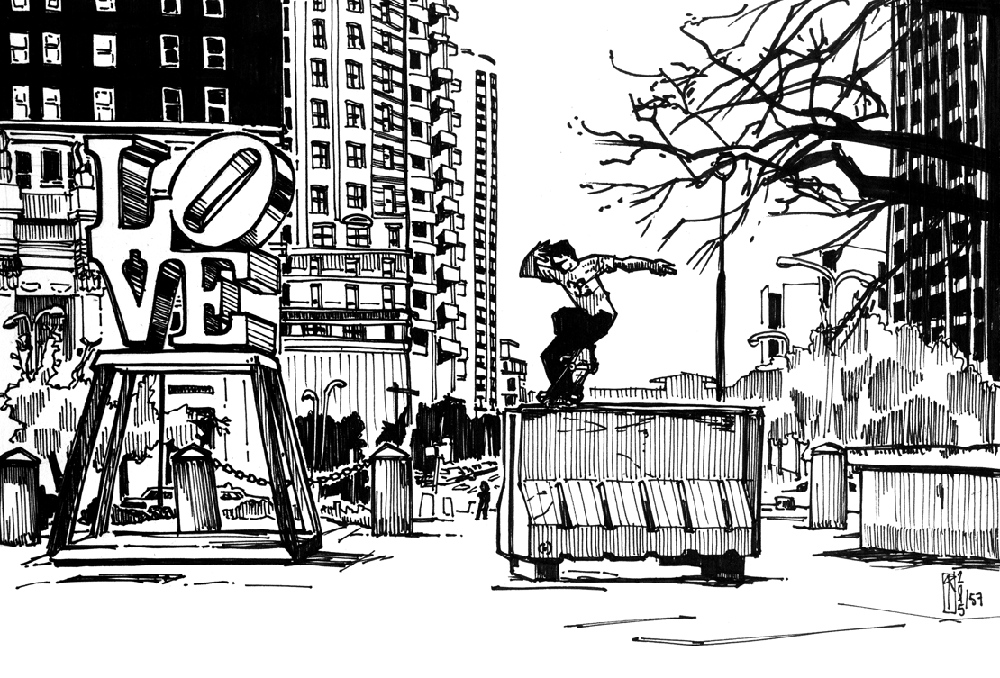
“BECAUSE I LIVE SOMEWHERE THAT’S NOT ‘HAPPENING,’ I’M FORCED TO WORK HARDER AND APPROACH THINGS DIFFERENTLY. AND THAT SETS ME APART FROM A LOT OF ARTISTS WHO LIVE IN A ‘BIG’ CITY.”
I’d say that where you live, outside of the large cities in the Netherlands, where most of your audience lives, makes it easier to stay “blind” like that.
I live in Roermond, in the most southern part of the Netherlands. It’s quite far away from big cities like Amsterdam and Rotterdam. When I started out as an artist, I must admit that I wasn’t really stoked to work in this area. There’s virtually no one to work with, to talk about your art or being an artist. Most of my friends from school moved to different cities, and there aren’t a lot of other artists in this area of the country. So it’s a lot tougher to be an artist here, a lot less opportunities. At first, I was focused on the big cities in the Netherlands: Amsterdam and Rotterdam. Each one of those cities is about two hours away from me. But after a while, I started to realize that Cologne, Germany is only an hour away. Dusseldorf: 45 minutes. Then it came to me: I’m in a much more central location over here than if I lived in Amsterdam. It changes your attitude, you’re not thinking local, or even national. My focus started to shift to international, or even continental—Europe. And that leads to different aspirations. I’m not looking to conquer my city because there’s not a lot to conquer. I want to go bigger. I’m not looking at what other people in my city are doing—since there are so few of them—I’m looking at other international guys. I want to be like Stash or Futura. Of course, my name isn’t as big as theirs, but I believe I can get to that level where I can work with an international brand and get my product on the shelves of stores in different countries. And that approach has helped me. I’m from a city no one knows, but that’s my graphic when you visit the Foot Patrol website. Because I live somewhere that’s not “happening,” I’m forced to work harder and approach things differently. And that sets me apart from a lot of artists who live in a “big” city.
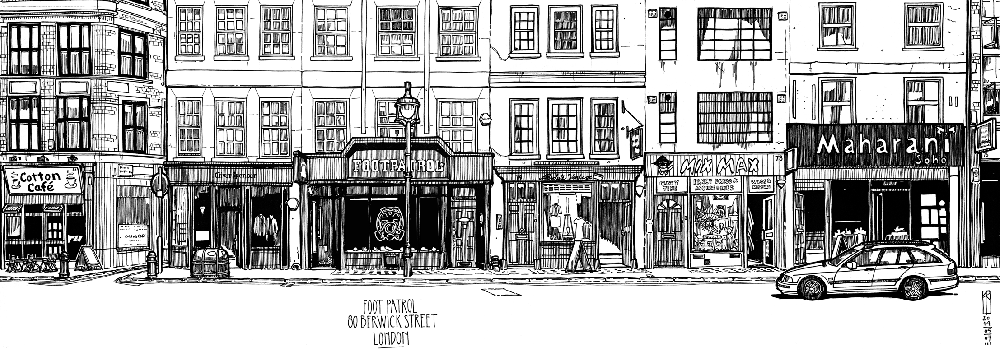
Can you tell us something about your work routine?
It’s old school, pretty straightforward. I used to work in dummies, black books—something I’ve been using since my early graffiti days. I love the concept, it’s an empty book and you just fill it up. It’s an instant portfolio. Some people prefer to work on single sheets, but I tend to lose a lot of stuff, so having everything in one place works a lot better for me. I’m part of the Pink Pig World Arts team, so I strictly use their sketchbooks. For my sketches, I use a blue mechanical pencil. Blue is a great color for sketching—after you ink the sketch lines and make the drawing final, the blue color won’t show when you copy or scan the drawing, leaving only the black lines. Besides that, I use several Artline pens in 0.3, 0.5, and 0.8 millimeter thickness. I also use a Sharpie. Once the drawing is finished, I scan it into Photoshop, edit the levels, and that’s it!
You recently worked with the classic British streetwear brand Addict. You designed a camouflage pattern that they turned into a full collection. Was it the first time you designed a camo?
I’ve always been a fan of Addict and the camos they’ve done with guys like C-LAW, SHE-ONE, Swifty, etc. I still have a few of those pieces in my closet. Back in 2014, when I just got back from London to deliver the storefront sketch I did for Foot Patrol, I received an email from Addict asking me if I wanted to work with them. I immediately thought the two were connected, but that turned out not to be the case. They sent me a disc with a variety of camo designs as inspiration. I also own the DPM book by Hardy Blechman, so I had plenty of material to help me work on my design. I started out by selecting a few camo patterns that appealed to me, including the British Woodland camo and the Tiger Stripe camo. The tiger camo had already been used quite recently by Addict, so my focus was fully on the British Woodland one. I took that camo and shaded it, which makes it a lot more organic. I picked basic black and white to make it more of an urban camo than a classic forest camo—who the hell wears camouflage in the forest these days? Within the pattern, I’ve hidden four elements that are very close to me, but I leave it up to you to find them in there. They’ve used it for a jacket, sweatpants, sweaters, caps, and T-shirts, and it turned out amazing.
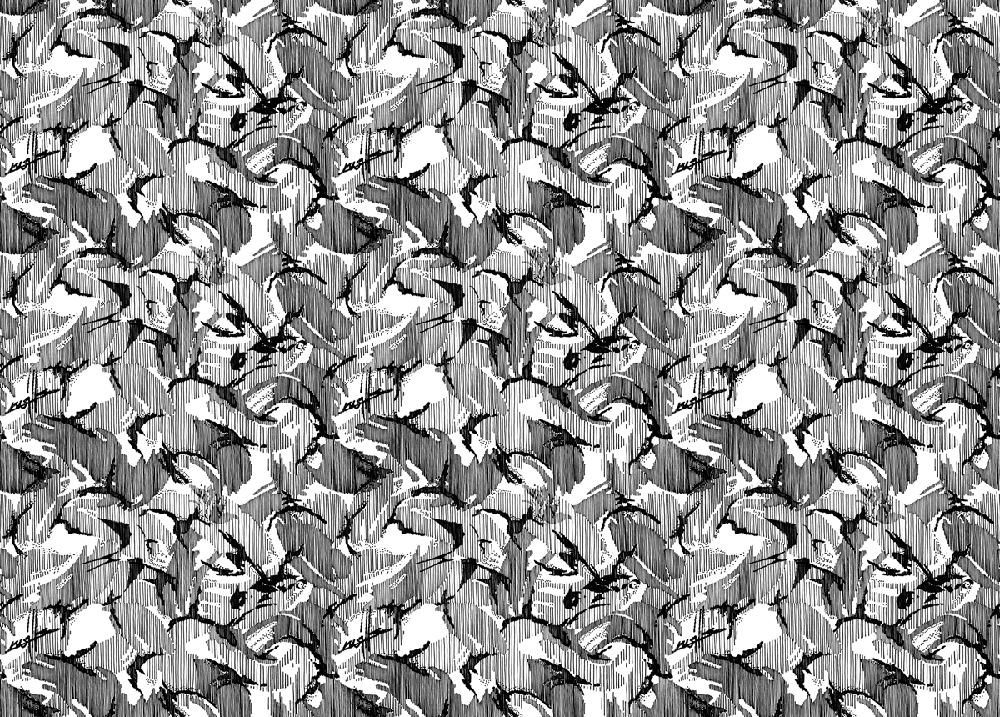
Out of all the projects you’ve worked on, which one is your favorite?
Tough question… The various projects I’ve done for AFEW store in Dusseldorf are definitely among my favorites. Dusseldorf has the largest Japanese community of Germany, and every year, they celebrate Japanese culture with Japan Day. Over the last few years, AFEW and ASICS have organized events around the store on Japan Day, and I’ve done the art work for it every year. But in the end, I think that I’m the most proud of the 365 day Draw Challenge I did. It helped me process a lot of things and it also lead to a lot of new assignments as well. It was a hard one to finish, it got very emotional at times, like drawing a portrait of my mother on the first anniversary of her death. It changed the way I looked at the world, I met new people, and touched people with my art. I’m looking into combining all the drawings I made that year into a book, that will hopefully will be released this year as part of my fifth anniversary as Kwills.
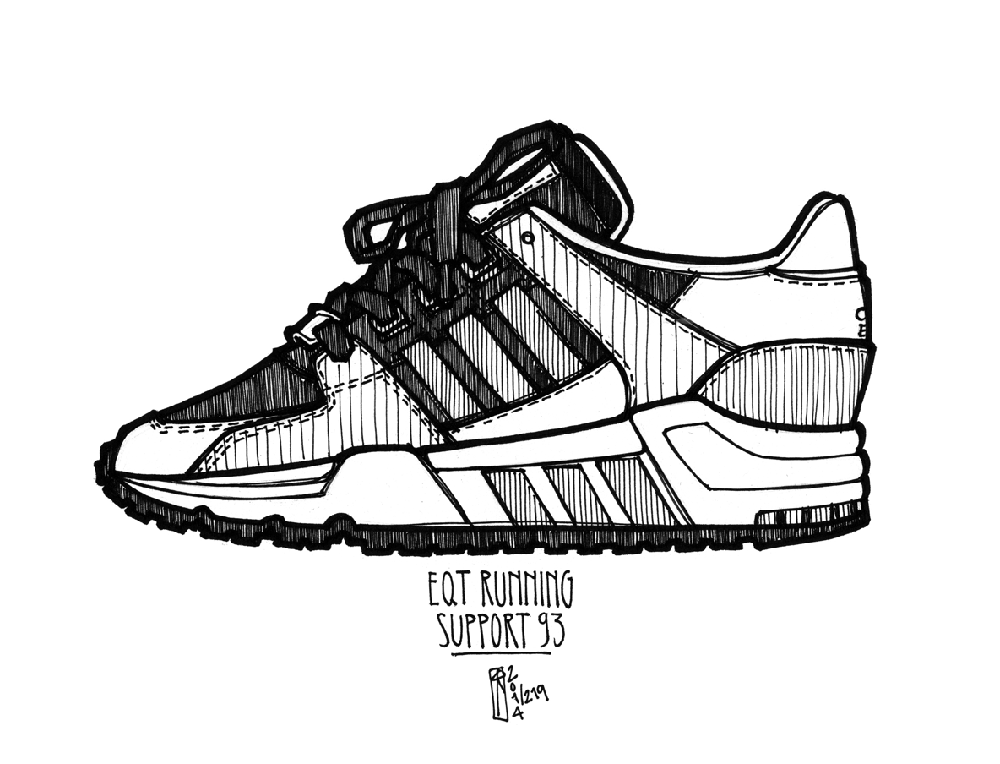
***
You can find all of Kwills’ drawings on his website. Follow him on Instagram for the latest updates.

